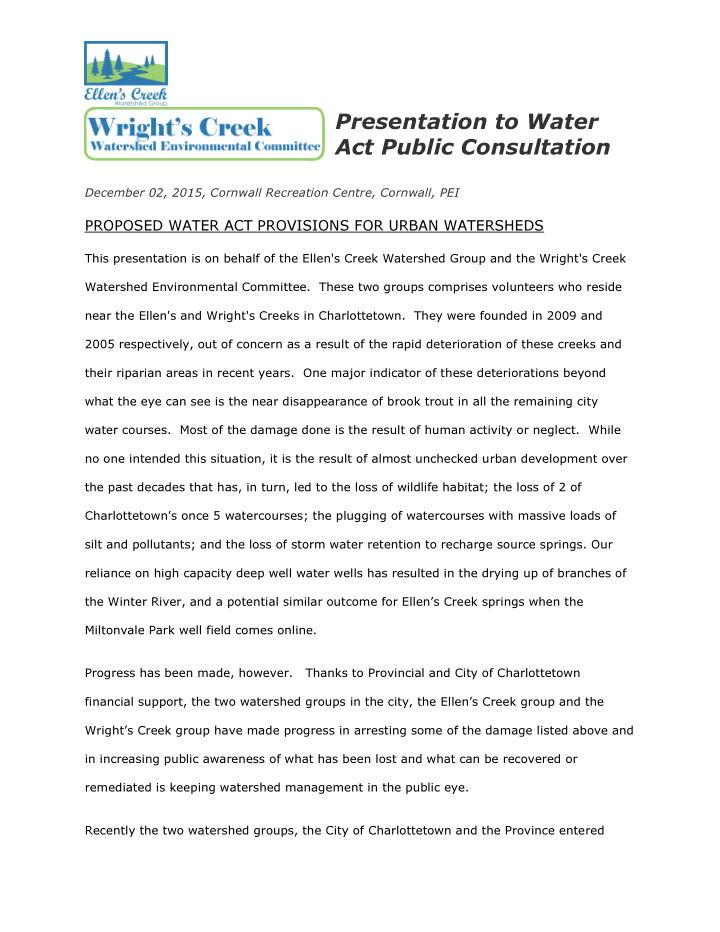



Presentation to Water Act Public Consultation December 02, 2015, Cornwall Recreation Centre, Cornwall, PEI PROPOSED WATER ACT PROVISIONS FOR URBAN WATERSHEDS This presentation is on behalf of the Ellen's Creek Watershed Group and the Wright's Creek Watershed Environmental Committee. These two groups comprises volunteers who reside near the Ellen's and Wright's Creeks in Charlottetown. They were founded in 2009 and 2005 respectively, out of concern as a result of the rapid deterioration of these creeks and their riparian areas in recent years. One major indicator of these deteriorations beyond what the eye can see is the near disappearance of brook trout in all the remaining city water courses. Most of the damage done is the result of human activity or neglect. While no one intended this situation, it is the result of almost unchecked urban development over the past decades that has, in turn, led to the loss of wildlife habitat; the loss of 2 of Charlottetown’s once 5 watercourses; the plugging of watercourses with massive loads of silt and pollutants; and the loss of storm water retention to recharge source springs. Our reliance on high capacity deep well water wells has resulted in the drying up of branches of the Winter River, and a potential similar outcome for Ellen’s Creek springs when the Miltonvale Park well field comes online. Progress has been made, however. Thanks to Provincial and City of Charlottetown financial support, the two watershed groups in the city, the Ellen’s Creek group and the Wright’s Creek group have made progress in arresting some of the damage listed above and in increasing public awareness of what has been lost and what can be recovered or remediated is keeping watershed management in the public eye. Recently the two watershed groups, the City of Charlottetown and the Province entered
into a formal partnership aimed at creating a citywide watershed management plan to be developed over the next 5-10 years. The target of this plan is to stop the watercourse, riparian and habitat drainage and begin the process of repair and restoration. While both city watershed groups are pleased with this development, all parties to this partnership are aware that the intended progress will not come easily or perhaps at all without statutory provisions in a new Water Act, such as those outlined below: Our recommendations focus solely on urban watersheds within the two cities and the incorporated towns in the province. This is because of our belief that urban watershed management challenges are sufficiently unique to set them apart from their rural “cousins” in terms of needed legislative protection. RECOMMENDATIONS: THAT with respect to water courses lying within Island cities and towns, a Water Act authorize government to: 1 (a) For new developments, define water course buffer zones based on degree of watershed slope and on the nature of the related riparian topography. The specific degrees of slope and associated buffer zone widths would be authorized under subordinate regulatory instrument. 1 (b) Complete topographical reviews to assess the degree of topographical health and durability with such assessment being factored into buffer zone width calculations. 2 (a) For developed land, create financial and other incentives for existing landowners to adopt for their holdings measures outlined in 1 a) and 1 b) above.
3. A Water Act should require cities and towns to: 3 (a) End current ditch-infilling in favour of best storm water management practices in other similar settings elsewhere. If ditches must be filled in, storm water retention basins of an equivalent area to the ditches should be created. 3 (b) Develop a culvert replacement capital plan in consultation with the Province and the Federal government to address the increasing inadequacy of culverts to channel storm water. The culverts should be sized to prevent flooding and water retention and, when roadways cross streams, the culverts should allow fish passage. 3 (c) Enact cosmetic herbicide and pesticide bans with enforcement resources allocated from provincial resources. 3 (d) Require towns and cities using deep wells as a source of their water supplies to create year-round strictly-enforced water conservation measures such as water meters where financial charges increase with use, restricted water use practices, and water retention approaches that result in increased storm water hold back. 3 (e) Create a public communication and awareness approach that outlines the value of urban watershed management and the positive role residents can play in urban watershed management.
Recommend
More recommend